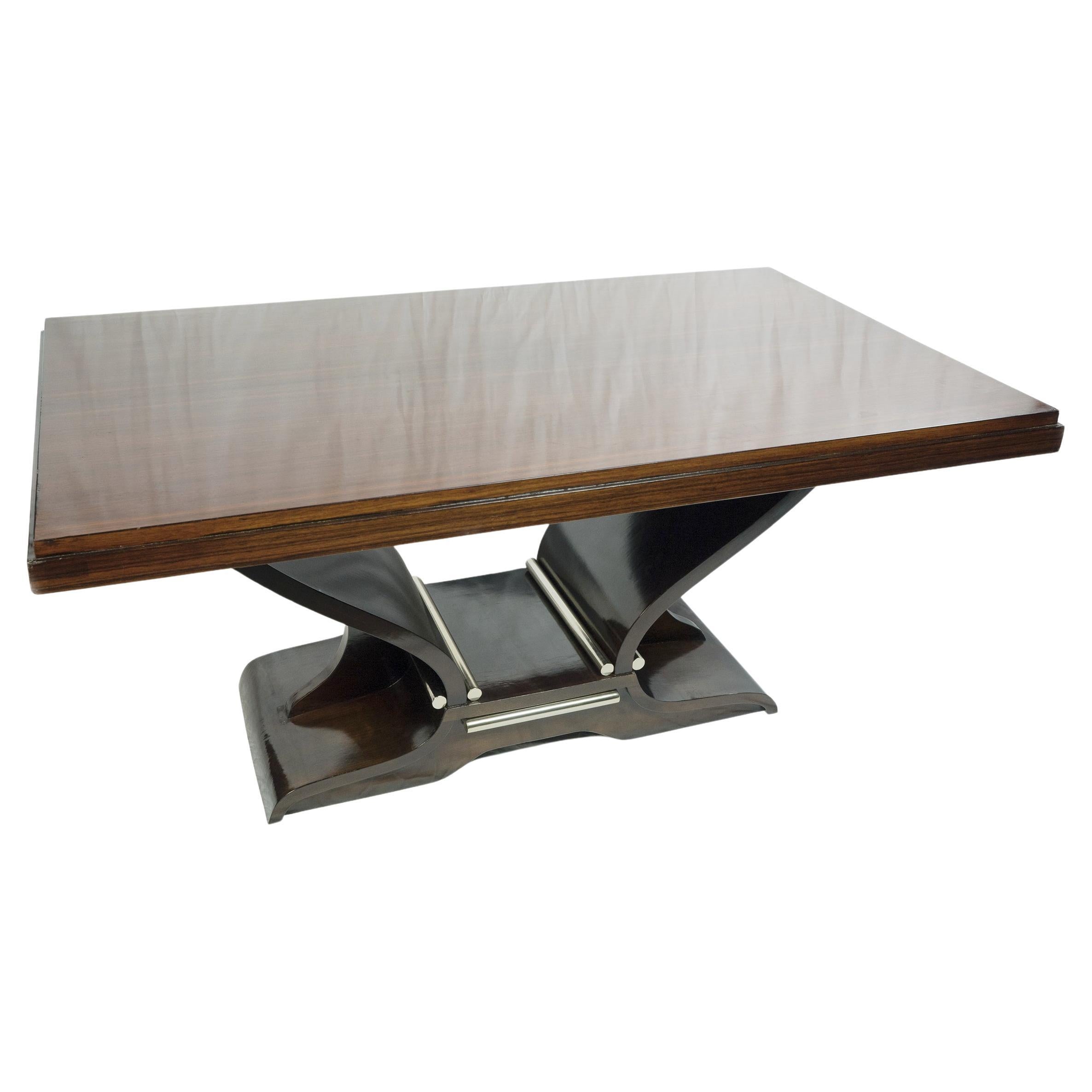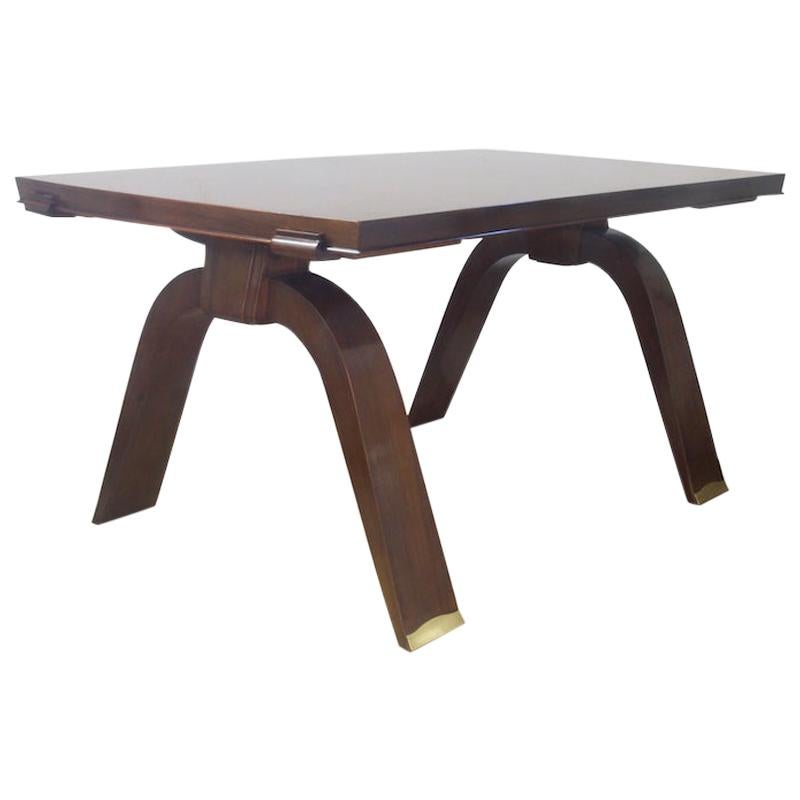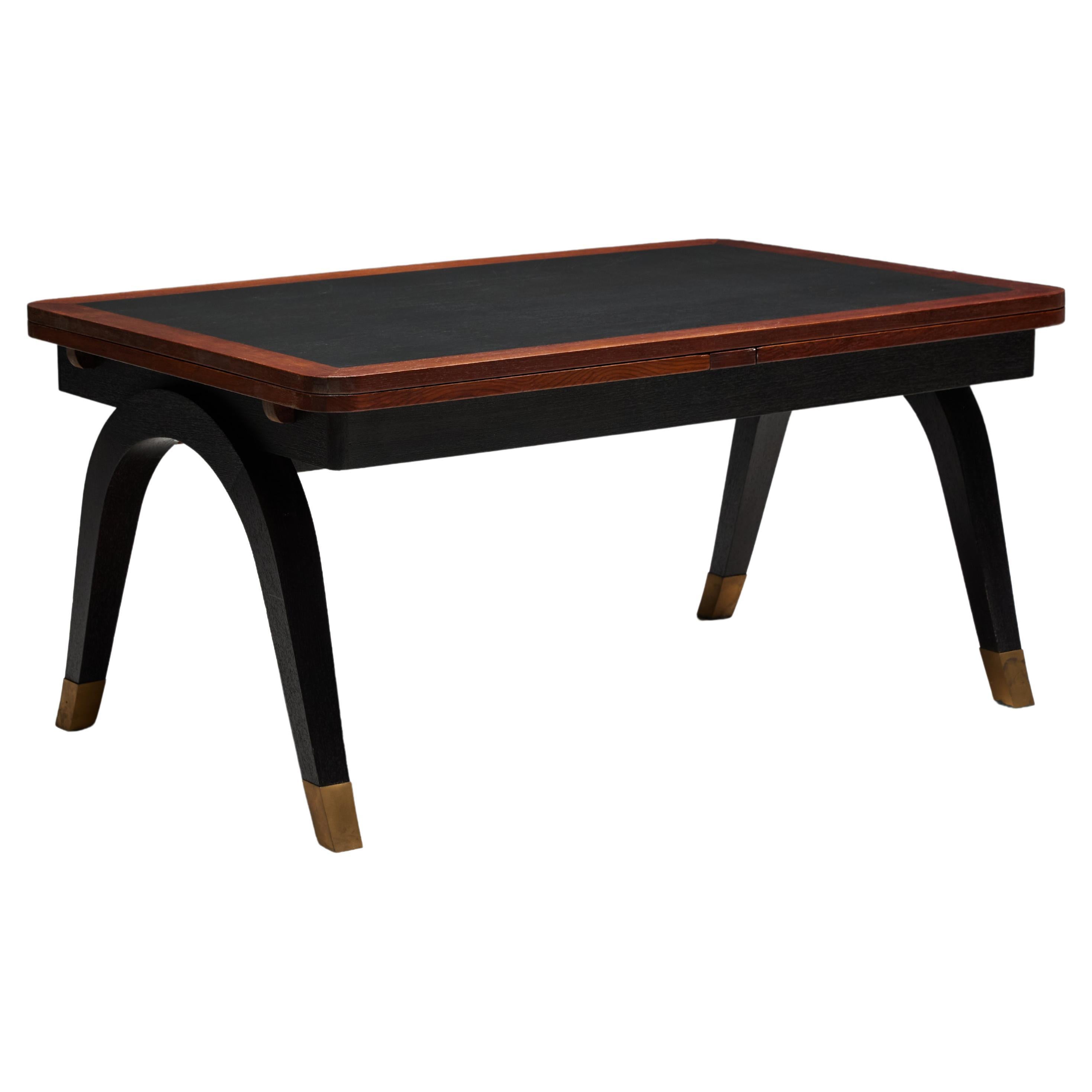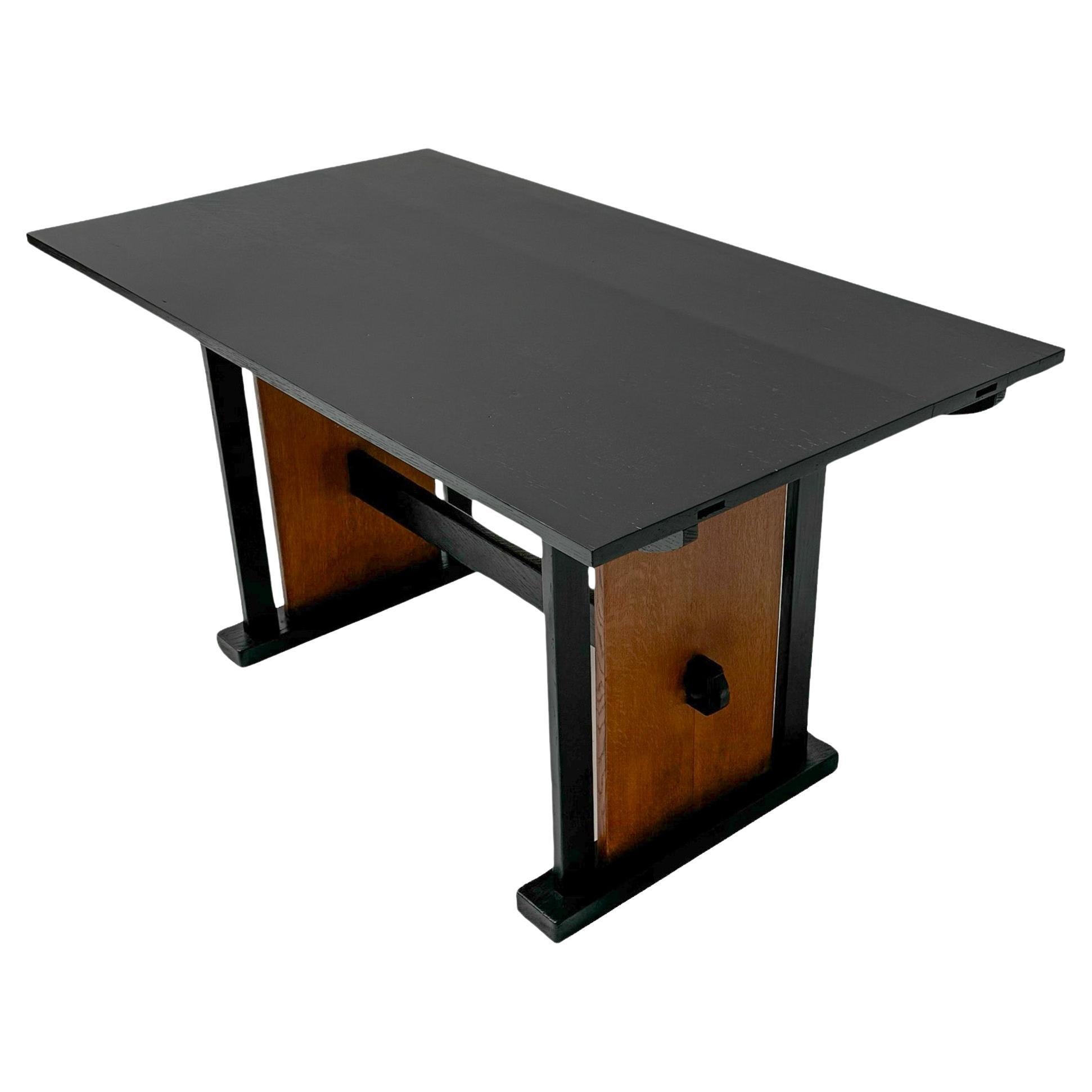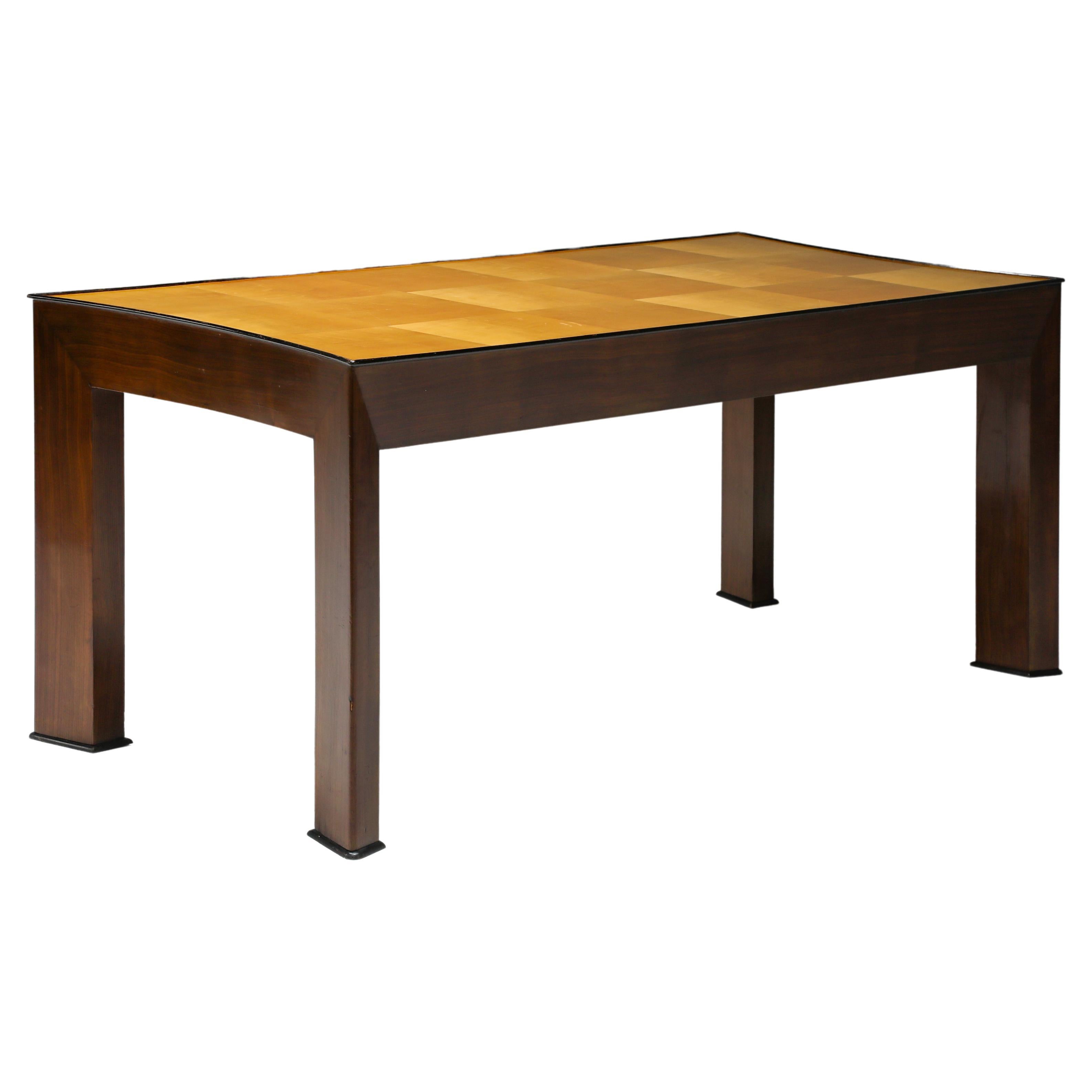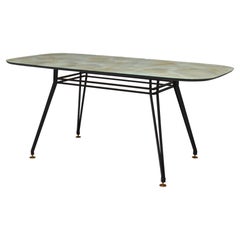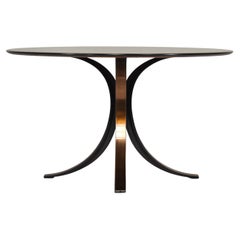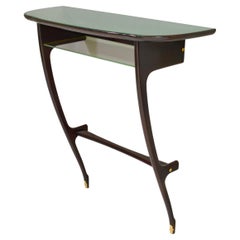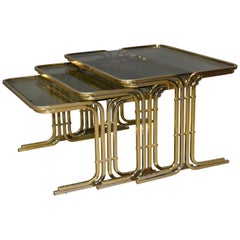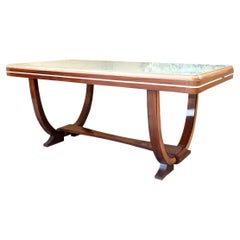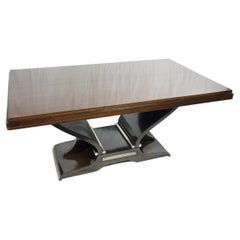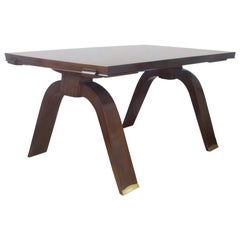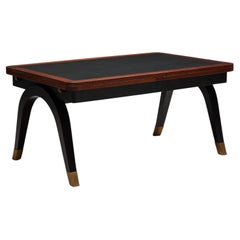Items Similar to Osvaldo / Gaetano BORSANI Art-Deco Dining table / desk - Italy, circa 1930-50
Want more images or videos?
Request additional images or videos from the seller
1 of 21
Osvaldo / Gaetano BORSANI Art-Deco Dining table / desk - Italy, circa 1930-50
$10,706.14
£7,856.26
€8,900
CA$14,554.75
A$16,303.19
CHF 8,475.84
MX$201,311.54
NOK 107,975.58
SEK 102,074.12
DKK 67,745
Shipping
Retrieving quote...The 1stDibs Promise:
Authenticity Guarantee,
Money-Back Guarantee,
24-Hour Cancellation
About the Item
About Gaetano and Osvaldo Borsani
Osvaldo Borsani (born 1911, Varedo, Italy–died 1985, Milano, Italy) was an Italian designer and architect, born into a family of furniture makers with along and well established artisanal tradition.
His father, Gaetano Borsani, owned his own furniture shop, the Atelier di Varedo, where the 16-year-old Osvaldo received his first training. At that time, the designer of the atelier was the architect Gino Maggioni, who brought with him influences of the early 20th century Jugendstil movement from Vienna and who instilled in the young Borsani an appreciation for the arts and crafts and furniture making. Osvaldo Borsani first studied fine arts at Accademia di Belle Arti di Brera in Milan, graduating in 1931, and then pursued studies in architecture at Politecnico di Milano, where he graduated in 1936.
Designer: Gaetano / Osvaldo Borsani
Manufacturer:
Country: Italy
Model: dining table / desk
Design period: 1930-50
Date of manufacturing: 1930-50
Size in cm: WxDxH 199x95x80 cm (the table can be lowered 4 cm on request)
Material: Burl wood / Black lacquered wood / Walnut / Black glass
Condition: Good / The black lacquered edges have wear and scratching due to use / The glass has light scratching due to use / Signs of age and use
About Gaetano and Osvaldo Borsani
Osvaldo Borsani (born 1911, Varedo, Italy–died 1985, Milano, Italy) was an Italian designer and architect, born into a family of furniture makers with along and well established artisanal tradition.
His father, Gaetano Borsani, owned his own furniture shop, the Atelier di Varedo, where the 16-year-old Osvaldo received his first training. At that time, the designer of the atelier was the architect Gino Maggioni, who brought with him influences of the early 20th century Jugendstil movement from Vienna and who instilled in the young Borsani an appreciation for the arts and crafts and furniture making. Osvaldo Borsani first studied fine arts at Accademia di Belle Arti di Brera in Milan, graduating in 1931, and then pursued studies in architecture at Politecnico di Milano, where he graduated in 1936.
In 1933, two years before graduating as an architect, Borsani designed the Casa Minima project for the V Triennale di Milano (Milan Triennial), along with architects Cairoli and Varisco. This project earned him a silver medal for its Rationalist code and geometries, and he received positive reviews from the critic Edoardo Persico of Casabella magazine. Villa Borsani And Other Prominent Architectural Work In 1937, Osvaldo Borsani designed Villa Presenti in Forte dei Marmi, a sea town in Tuscany where the Italian aristocracy and industrial elite would build their houses, a project that displayed the same rationalistic rigor displayed in Casa Minima, but softened by the use of mediterranean finishes and materials.
Villa Borsani designed by Osvaldo Borsani. Varedo, Italy Villa Borsani. Varedo, Italy In 1943, Osvaldo designed and built his own house, the Villa Borsani, in Varedo, which, despite being conceptualized under strict Rationalist principles, incorporated objects and art of younger artists that communicate a freer approach to the human expression. The Villa Borsani project involved artists such as Adriano Spilimbergo, Fausto Melotti, Lucio Fontana (who made the ceramic fireplace and the ceramic Madonna), and Agenore Fabbri (who made the bronze statue in the staircase). To this day, Villa Borsani has been preserved with most of its original furniture and it remains with Osvaldo Borsani’s family along with the extensive archives of his work.
Osvaldo Borsani As a Successful Product and Furniture Designer After Villa Borsani, Osvaldo continued to develop many projects for the Milanese bourgeoisie, frequently with many of the same artists whom he employed for his villa. A particularly strong relationship was the one that Osvaldo developed with artist Lucio Fontana, a close friend since the time of the Accademia de Belle Arti di Brera, and whom Borsani assigned to make a large metal balcony for the Tecno company in 1956. Osvaldo Borsani’s design work, just as his larger architectural projects, which he also considered design work, very often incorporated elements created by other artists and designers such as: Roberto Crippa, Arnaldo and Giò Pomodoro, Agenore Fabbri, Fausto Melotti, Andrea Cascella, and Lucio Fontana. Of all of these collaborations, the one that Borsani forged with Lucio Fontana resulted in the creation of many of Borsani’s furnishing designs of the late 1930s and 1940s. With Fontana, Borsani integrated sculptural ceramic and bronze elements, wood and gilded stucco, and interventions on glass tabletops with decorations, to name a few design elements, to his furniture designs. In 1953, Osvaldo understood the imminent need to transform the artisan approach to furniture making into a modern industry capable of meeting a larger demand at more accessible prices. It was then that Osvaldo and his twin brother Fulgenzio founded the manufacturer Tecno, with the aim of utilizing modern manufacturing techniques that will deliver high-quality furniture to a larger international market. Initially, Tecno manufactured only Borsani’s furniture designs, and, although he continued to design furniture and objects until the early 1980s, by the late 1950s, Tecno also manufactured furniture from other designers, including Vico Magistretti, Roberto Mango, Gae Aulenti, Eugenio Gerli, Carlo de Carli, and Gio Ponti. Black P40 chair by Osvaldo Borsani for Tecno (1955) Italian design and furniture gallery Casati Gallery P40 chair by Osvaldo Borsani for Tecno (1955) Among the most successful and iconic Tecno designs are the 1954 D70, a sofa that can assume approximately 20 positions; the 1955 P40 adjustable lounge chair, described as a “machine for sitting,” which could assume 486 distinct postures; the 1954 T41 dining table; the 1961 AT 16 coat rack; the 1965 Canada chair; the 1968 Graphis office furniture system; and the 1972 P128 office chair. Along with Eugenio Gerli, Marco Fantoni, his brother Flugenzio, and his daughter Valeria, Osvaldo Borsani founded Centro Progetti Tecno (1970), a design shop focused on creating innovative products and interiors for work and school environments. Early furniture pieces by Tecno can be found in the permanent collections of the MoMA in New York, the Victoria & Albert Museum in London, the Centre Pompidou in Paris, the Trienalle di Milano Museum, and the Neue Sammlung in Munich. In 2018, the Triennale di Milano organized a retrospective of Osvaldo Borsani’s work. The exhibition “Osvaldo Borsani” was co-curated by Tommaso Fantoni, Borsani’s grandson, and Norman Foster, who had worked with Borsani at Tecno–where he designed the Nomos table and furniture systems for airport and museums.
- Attributed to:Gaetano Borsani (Designer)Osvaldo Borsani (Designer)
- Dimensions:Height: 31.5 in (80 cm)Width: 78.35 in (199 cm)Depth: 37.41 in (95 cm)
- Style:Art Deco (Of the Period)
- Materials and Techniques:
- Place of Origin:
- Period:
- Date of Manufacture:circa 1930-50
- Condition:Wear consistent with age and use. Minor fading. scratching on the glass scratching on the black lacquer edge.
- Seller Location:Pijnacker, NL
- Reference Number:1stDibs: LU1712239762042
About the Seller
5.0
Gold Seller
Premium sellers maintaining a 4.3+ rating and 24-hour response times
Established in 2012
1stDibs seller since 2015
256 sales on 1stDibs
Typical response time: 1 hour
- ShippingRetrieving quote...Shipping from: Pijnacker, Netherlands
- Return Policy
Authenticity Guarantee
In the unlikely event there’s an issue with an item’s authenticity, contact us within 1 year for a full refund. DetailsMoney-Back Guarantee
If your item is not as described, is damaged in transit, or does not arrive, contact us within 7 days for a full refund. Details24-Hour Cancellation
You have a 24-hour grace period in which to reconsider your purchase, with no questions asked.Vetted Professional Sellers
Our world-class sellers must adhere to strict standards for service and quality, maintaining the integrity of our listings.Price-Match Guarantee
If you find that a seller listed the same item for a lower price elsewhere, we’ll match it.Trusted Global Delivery
Our best-in-class carrier network provides specialized shipping options worldwide, including custom delivery.More From This Seller
View All1950's Italian Dining Table with Metal Base, Glass Top and Brass Details
By Ignazio Gardella, Ico Parisi
Located in Pijnacker, Zuid-Holland
Italian dining table from the 1950’s.
The table has a black lacquered metal base with in height adjustable brass feet. The table top has a wood edge with a glass top and a stone prin...
Category
Vintage 1950s Italian Mid-Century Modern Dining Room Tables
Materials
Metal, Brass
$2,368 Sale Price
48% Off
Osvaldo Borsani T69 Round Dining Table by Tecno, Italy, circa 1960
By Osvaldo Borsani, Tecno
Located in Pijnacker, Zuid-Holland
Iconic T69 dining table by Osvaldo Borsani for TECNO, Italy – circa 1960.
Designer: Osvaldo Borsani
Country: Italy
Model: T69 dining table
Design period: circa 1960
Date of manu...
Category
Vintage 1960s Italian Mid-Century Modern Dining Room Tables
Materials
Metal, Brass
Console Table by or in the style of Ico Parisi in Ebony and Glass - Italy, 1950s
By Ico Parisi, Luisa Parisi, Ico & Luisa Parisi
Located in Pijnacker, Zuid-Holland
Console Table by or in the style of Ico Parisi in Green glass, Brass and Ebonized wood – 1950s, Italy.
The wood is a very dark brown cherry black colour.
The table is attached to t...
Category
Vintage 1950s Italian Mid-Century Modern Console Tables
Materials
Brass
Italian 1970s Nesting Tables Gold / Smoked Glass, Italy, circa 1970
Located in Pijnacker, Zuid-Holland
Amazing set of three gold colored Italian 1970s nesting tables. The set resembles a Great Gatsby or Hollywood Regency style.
Designer: Unknown
Manufacturer: Unknown
Country:...
Category
Vintage 1970s Italian Hollywood Regency Nesting Tables and Stacking Tables
Materials
Metal
$1,116 Sale Price
48% Off
Charles Hollis Jones X Console Table
By Charles Hollis Jones
Located in Pijnacker, Zuid-Holland
Charles Hollis Jones
Charles Hollis Jones is an American designer and artist, born in 1945 in Bloomington, Indiana. He is known for his innovative work in sculpturing, furniture and ...
Category
Vintage 1980s American Hollywood Regency Console Tables
Materials
Brass
Early Michael Thonet Bistro Dining Table in Bentwood and Cane - Austria
By Thonet, Michael Thonet
Located in Pijnacker, Zuid-Holland
Bistro dining table in bentwood and cane designed by Michael Thonet. Originally designed in the 1860s and produced by Thonet in the 20th century by multiple factories.
Size:
chairs: 57x49x96.5 seat height 46 Arm height 67 centimeter
table: ø85.5 height 75 centimeter
Condition: used. The lacquer has worn out on some places. The stained beech wood has discoloration. Cane in the table top is good.
The cane in two seats is damaged. The cane in one back is damaged. One arm has a crack in a curve. Some small wood details are missing. The cane can be repaired or replaced professionally on request.
Michael Thonet
The development of bentwood for use in furniture is one of history’s most significant innovations in design. A range of renowned mid-century modern designers such as Alvar Aalto, Arne Jacobsen, and Charles and Ray Eames drew heavily on this technological advancement, and the success of their enduring works owes to the efforts of pioneering German-Austrian industrialist and designer Michael Thonet — founder of Thonet and widely considered the father of bentwood furniture.
Bentwood furniture dates as far back as the Middle Ages, but it is the 19th-century cabinetmaker and master of parquetry Michael Thonet who is most often associated with this now-classic technique. Thonet in 1856 patented a method for bending solid wood through the use of steam, and from there, the bentwood look skyrocketed to furniture fame. He experimented with bending birch rods into rounded shapes — forming delicately seductive, curving Art Nouveau creations that were a daring departure from the heavy, hand-carved designs attributed to his contemporaries.
The Boppard-born Thonet honed his carpentry skills in his father’s workshop, where he carried out experiments with plywood and modified the Biedermeier chairs that populated the studio. He received an invitation from Austrian Chancellor Prince Metternich to contribute Neo-Rococo interiors to the Liechtenstein City Palace in Vienna. From there, the cabinetmaker gained international recognition, including at London’s Great Exhibition of 1851, which featured works created by members of the Arts and Crafts movement as well as industrial products. Thonet showed a range of furniture at the fair and won the bronze medal for his bentwood chairs. He incorporated his family’s company, the Thonet Brothers — or Gebrüder Thonet — with his sons in 1853.
Considered the world’s oldest mass-produced chair, Michael Thonet’s ubiquitous Chair No. 14 demonstrated that his patented bentwood technology made it possible to efficiently produce furniture on an industrial scale.
Often called the Coffee House chair — the company’s first substantial order was for a Viennese coffeehouse — the No. 14 remains an icon. Thonet originally designed the chair in 1859, and it is considered the starting point for modern furniture. Composed of just six parts, the chair, with its simple, lightweight design, belies its durability. The No. 14 was followed by the No. 18, or the Bistro chair, in 1867, and the 209, or the Architect’s chair, of which Le Corbusier was a fan. (The influential Swiss-French architect and designer used Thonet furniture in his Pavillon de l’Esprit Nouveau at the 1925 International Exposition of Decorative Arts in Paris.)
The business began mass-producing furniture. By the end of the 1850s, there were additional Thonet workshops in Eastern Europe and hundreds of employees. Michael Thonet’s reputation attracted the attention of notable architects including Otto Wagner, Marcel Breuer and Ludwig Mies van der Rohe.
Thonet’s patented bentwood technology also yielded an improvement to rocking chairs for his company — in the middle of the 19th century, Michael produced a series of rockers in which the different curved parts were integrated into fluid, sinuous wholes. Thanks to Thonet, the humble rocker acquired something unexpected: style. And bentwood furniture was embraced by a series of design greats — the innovation can be found in the seating that Josef Hoffman designed for Thonet, in the elegant Superleggera chair created by Gio Ponti and Alvar Aalto’s expressive Paimio armchair...
Category
Antique 1860s Austrian Rococo Revival Dining Room Tables
Materials
Cane, Bentwood
$2,165 Sale Price
20% Off
You May Also Like
1940s attributed to Osvaldo Borsani Design Long Dining Table, Italy
By Osvaldo Borsani
Located in Biella, IT
attributed to Osvaldo Borsani Italy design big table years 50
Veneered with mahogany, root veneer and other types of wood, and
Green glass top with decoration. Measure length 74...
Category
Vintage 1940s Italian Art Deco Dining Room Tables
Materials
Art Glass, Wood
Art Deco Jules Leleu Style Dining Table, 1930s (20th Century)
Located in Lisbon, PT
This stunning french dining table (1930s) features a classic varnished with elegant curves and integrated extensions, hardware and chromed small details, a Jules Leleu style Design p...
Category
20th Century French Art Deco Dining Room Tables
Materials
Metal, Chrome
Jules Leleu Dining Table / Desk circa 1937
By Jules Leleu
Located in CA, CA
A distinctive Jules Leleu dining table, circa 1937. that can also be used as a desk.The table has elegant curved lines, sweeping arched legs and is finished in gilt brass.
Literatur...
Category
Vintage 1930s French Art Deco Dining Room Tables
Materials
Wood
Art Deco Dining Table, Belgium, 1970s
Located in Antwerp, BE
Walnut and brass Art Deco dining table, a true masterpiece custom-designed for a castle in Ghent, Belgium. Crafted with precision and elegance, this table seamlessly combines the ric...
Category
Mid-20th Century Belgian Art Deco Dining Room Tables
Materials
Brass
Art Deco Modernist Extendable Dining Room Table by Cor Alons, 1927
By Cor Alons
Located in Amsterdam, NL
Magnificent and ultra rare Art Deco Modernist extendable dining room table.
Design by Cor Alons for Fa. Winterkamp & Van Putten in 1927.
Striking Dutch design from the 1920s.
Solid o...
Category
Vintage 1920s Dutch Art Deco Dining Room Tables
Materials
Oak
$8,661 Sale Price
20% Off
Art Deco Concave Dining Table, Italy, 1970s
Located in Antwerp, BE
Art Deco; Trompe l'Oeil; Italian Design; 1970's; concave dining table; mahogany, beech & ebonised wood; Italy;
Art Deco concave dining table, Italian design, 1970's. A beautifull...
Category
Vintage 1970s Italian Art Deco Dining Room Tables
Materials
Wood, Beech, Mahogany

